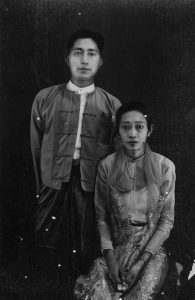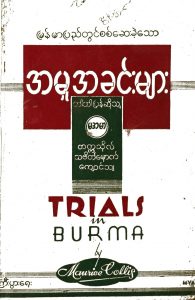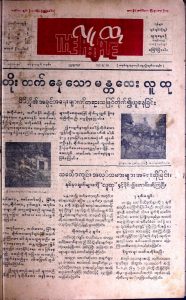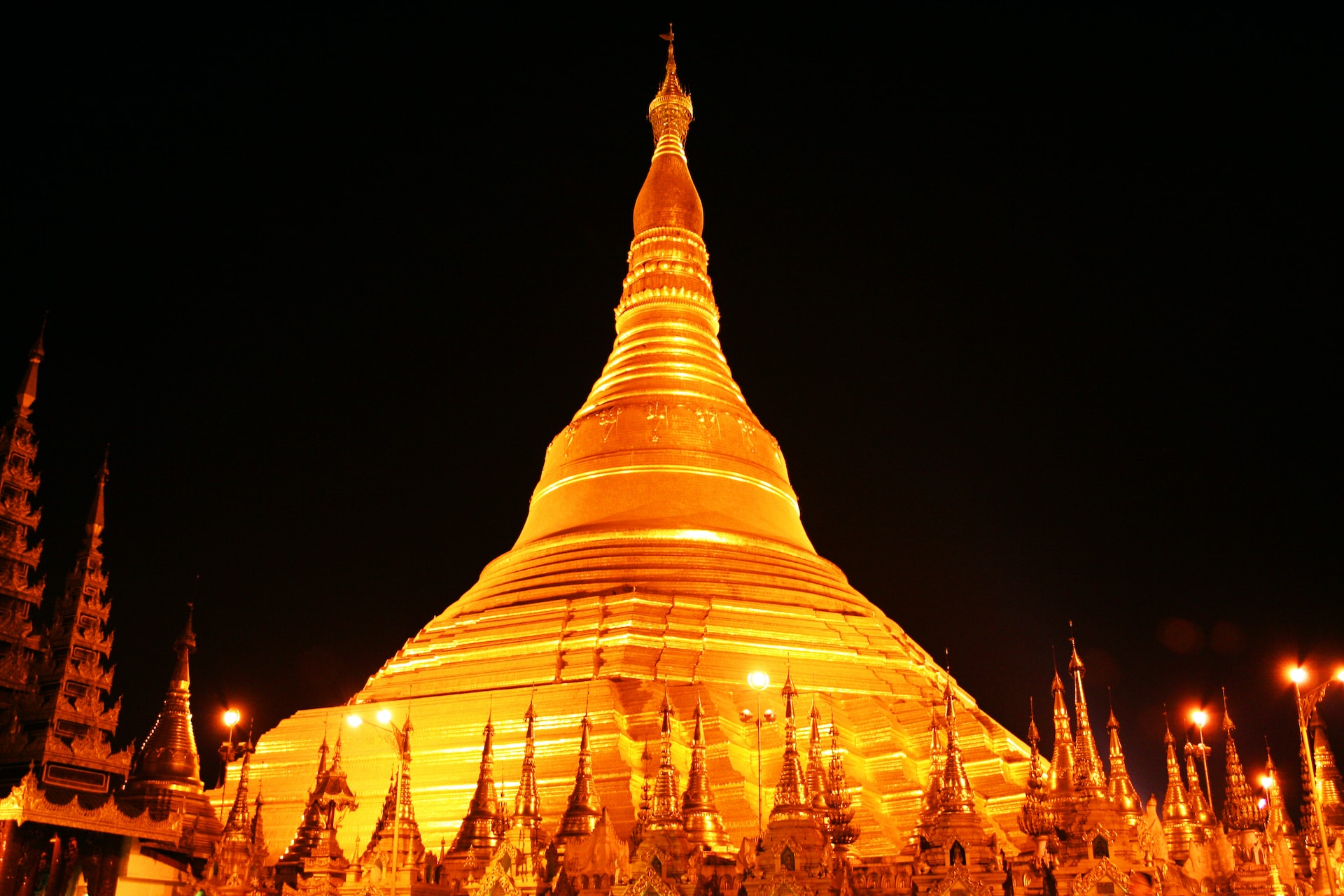 An independent and free press is always a challenge for authoritarian regimes. In this rare post, Bo Bo traces the history of one of Burma/Myanmar’s oldest — and still surviving — politically radical press, in colonial times and under military rule. It is a story of belief, resilience and, most importantly, courage of one radical couple, and their continuing legacy against the odds.
An independent and free press is always a challenge for authoritarian regimes. In this rare post, Bo Bo traces the history of one of Burma/Myanmar’s oldest — and still surviving — politically radical press, in colonial times and under military rule. It is a story of belief, resilience and, most importantly, courage of one radical couple, and their continuing legacy against the odds.
The 1930s saw the rise of radical press in Rangoon, which was also a hotbed of ultra-nationalism and left-wing political movements. Ko Hla (‘Mr Handsome’), a young clerk from the Rangoon Municipal Office, founded Kyi-bwa-ye (‘Improvement’), a monthly magazine which he published from 1933–42, with the help of friends from the Youth Improvement Society (YIS) — which was to also become the name of the publishing company. YIS was part of the moderate movements that had come up in opposition to colonial rule in Burma, and focused on rural development and youth issues. Kyi-bwa-ye became an intellectual rendezvous of young politicians and scholars from across the political spectrum, several of whom later became national élites in post-Independence Burma.
Literary Commune
Hla lived in rented houses near Sule Pagoda in the 1930s, hosting cousins and friends who could not pay their rent. One of his cousins joined Aung San’s Thirty Comrades in Japan to found the Burma Independence Army (BIA) in 1942, and another became the Chairman of the Communist Party of Burma in 1968. One close friend went on to become the Chief Editor of Kyemon (‘The Mirror’), a state-owned daily newspaper, after the military coup by General Ne Win in 1962. Ne Win himself was a clerk in the post office from where Hla sent love letters to his girlfriend Ahmar (‘Miss Strong’) in Mandalay (see Photo 1 below). Ahmar was also politically active, and a part of political networks. Aung San, the father of the Burmese independence, and his numerous friends in student unions were also classmates and comrades-in-boycott of Ahmar at Rangoon University (now University of Yangon).

Photo 1: Hla and Ahmar, studio photograph, Mandalay, ca 1948 © For copyright information, please see below.
Senior writers like P. Moe Nin and Maha Swe and student writers like Zawgyi and Minthu-wun wrote columns in Kyi-bwa-ye. A senior British civil servant like U Sein Tin (Theippan Maung Wa) contributed to the magazine with several pseudonyms, and Than Tun, a Communist, did as well. Coming from different backgrounds, these writers focused on social reforms and political development in Burma, and their writings led to literary modernisation. Kyi-bwa-ye became one of the first periodicals introducing young student writers and their modernised Burmese poetry and fiction to general readers outside the university. Hla also serialised Maha Swe’s articles on patriotism which called for fight against fear in the anti-colonial movement; luckily, these writings escaped British censorship.
From Social Improvement to People
In 1938, Hla published the first Burmese comic book Ko Pyoo hnit Ma Pyone by U Ba Gyan — which was also the author’s very first book. The publishing company was renamed Ludu (‘The People’) in 1945, and started publishing a journal (till the mid-1950s) and daily newspaper by the same name, and it has been active as one of the longest presses in Burma until now.
In the 1930s, it published some important books in the history of Burma’s publishing history. These included U Pu Gale’s Kabya Pyatthana (‘The Half-Caste Problem’ or ‘The Problem of Mixed Race’), Hla’s Soviet Russia (an early book on the USSR in Burmese) and Ahmar’s translation (from English) of Maurice Collis’ Trials in Burma, titled Bamapyi-dwin-sit-se-khe-thaw-ahmu-akhin-mya (see Image 2 below). In 1939, Hla moved to Mandalay to start a family with Ahmar; the publishing press moved with him.

Image 2: Cover image of Ahmar’s translation of Trials in Burma, published by Ludu, 1938
© For copyright information, please see below.
During the Second World War, in 1942, Ahmar and Hla moved the press around villages north of Mandalay. Their hut (inside a monastery) also served as the meeting point for revolutionaries like U Nu (the first prime minister of independent Burma in 1948), Soe (the first communist philosopher of Burma) and Thein Pe Myint (the first Communist Minister in the British Empire). Hla also worked with Colonel Ba Htoo from Aung San’s army for resistance in 1945; he also translated memoirs of Japanese soldiers to develop a good rapport with the invading Japanese fascist army. Interestingly, these translations also served as inspiration for young Burmese to join the resistance movement having faced the two invasions (of Japanese and Allied forces) in the Second World War.
As soon as Mandalay was liberated in March 1945, Hla, U Razak (educationist who was assassinated with Aung San in 1947) and their colleagues founded the first office of the Anti-Fascist Organisation (AFO) in Burma, ahead of the liberation of Rangoon in May 1945 (click here for an account from the website of the Royal Marines). Ludu journal and newspaper (re-named and re-established in 1945) became the propaganda wing of the AFO, leading to him and his wife being known later as ‘Ludu U Hla’ and ‘Daw Ahmar’ (see Image 3 below).

Image 3: Ludu — The People newspaper, front page, 24 April 1946
© For copyright information, please see below.
From Independence to Civil War
Hla resigned from Aung San’s umbrella league (Anti-Fascist People’s Freedom League) in 1946 after Communists were purged from it. Although he tried to stand for reconciliation and freedom, the country slipped into civil war after Aung San died (in 1947). Hla and his family narrowly escaped the threats of U Nu’s army in 1949, but the offices of Ludu were blown up because the army was mad at Ludu’s reports on the civil war. Hla was also detained (five times), once with his wife and youngest son in 1978.
However, Hla and Ahmar stood firmly for peace and prosperity for the nation until the Ludu newspaper was closed in 1967 by Ne Win’s regime. Although they were accused as communist sympathisers for trips to the Eastern Bloc and promoting socialism, and their newspaper spoke the loudest for the international and domestic peace movement, along with cultural renaissance in the post-colonial era. Ahmar became a famous biographer of performing artistes, and won the Anu-pyinnya-sarpay-su (‘Art & Literature Award’, state literary award) in 1964 for Pyi-thu-chit-thaw-anu-pyinnya-thae-mya (‘The Artists Loved by the People’). Hla established himself as a collector of folktales, published Hlaung-gyaint-hte-hma-nget-nge-mya (‘The Caged Ones’), a critique of the juvenile delinquency system, and press histories and social histories of the grassroots.
In 1966, Hla led a literary campaign to write Burmese in colloquial or spoken style, another step in literary modernisation of the 1930s. Hla, Ahmar and the historian Than Tun were the trio in this campaign along with young poets and writers of the University of Mandalay. Hla and Ahmar died respectively in 1982 and 2008 but they are still regarded as influential writers and journalists in Burmese press, succeeded by the writings of their politically active sons.
Political Press Culture
Hla and Ahmar’s press/publishing house was one of the milestones of the history of political press in Burma; dozens more flourished from the 1920s to the 1970s, though only a few of them remain today. They have all been rooted in or enmeshed with political vibrance, anti-colonialism and support for independence. Some of these presses and writers later aligned with the post-1948 state and army, while Leftists like Hla and some others remained in opposition until after the military coup of 1962.
As Burma has been under the military and quasi-military rule for six decades, the writings of these political presses become a threat for the military regimes even though army propaganda also follows the style of the nationalist press of the colonial days in using ultra-nationalism, militarism and anti-Western narratives. Presses like Ludu were heavily scrutinised from the 1970s to 2000s. Political participation of families who owned these presses in Burma was not uncommon; Aung San Suu Kyi herself is also a daughter of a statesman as well as an editor-cum-writer from the 1930s Rangoon presses like Nagani (‘Red Dragon’) and Dagon (‘Rangoon’). Thus, Hla’s sons (see Photo 4 below) also became rebels and popular writers. Once Ahmar, Hla’s widow, remarked: ‘If we do not write, there are people who will be happy for that.’

Photo 4: Family photograph in the backyard of Ahmar and Hla’s office/home, Mandalay, ca 1950 (from L-R: Ma Nwe (worked as cook in the household), Than Yin Mar (retired as Professor of Medicine from Mandalay General Hospital), Ahmar, Soe Win (killed in the purge of Communists in 1968), Hla, Po Than Gyaung (sitting on Hla’s lap; spokesperson for the Communist Party of Burma) © For copyright information, please see below.
So, writing itself is a political act in countries like Burma which is still in search of a fully-fledged independent media, ranking 151 (out of 179) in the ‘Reporters Without Frontiers’ index of press freedom in 2022.
*
The views expressed here are those of the author and not of the ‘South Asia @ LSE’ blog, the LSE South Asia Centre or the London School of Economics and Political Science.
This blogpost may not be reposted by anyone without prior written consent of LSE South Asia Centre; please e-mail southasia@lse.ac.uk for permission.
Banner and all other images/photographs © Ludu; reproduced with permission by author.
The ‘Myanmar @ 75’ logo is copyrighted by the LSE South Asia Centre, and may not be used by anyone for any purpose. It shows the national flower of Myanmar, Padauk (Pterocarpus macrocarpus), framed in a design adapted from Burmese ikat textile weaves. The logo has been designed by Oroon Das.







